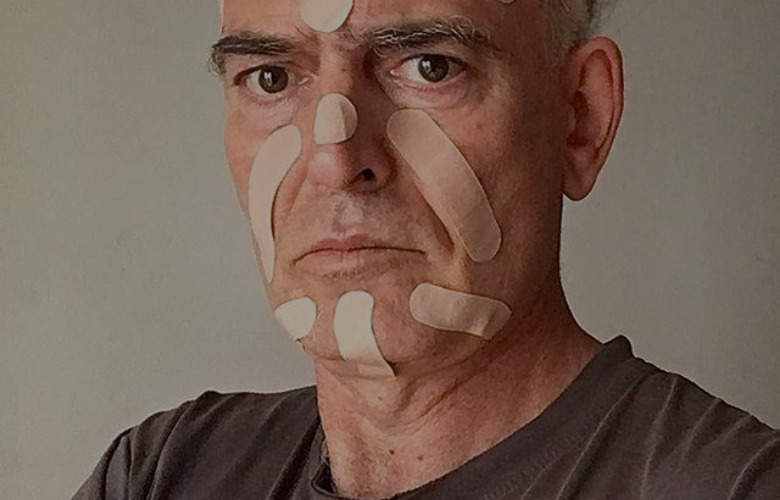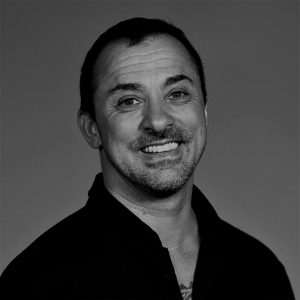
Thomas Schunke is a performance artist and filmmaker from Berlin, Germany. I met him in his home in Geneva, where we had a long chat about his life and work, creativity, the performing arts, and the future of performance. This portrait claims by no means to be complete. It is a moment in time, spent with an extraordinary artist.
Thomas studied art and film making in Berlin in the 80’s. He arrived in Geneva twenty-eight years ago, after living in Zurich, Rome, and Sicily for a while. At first, he found work in the vineyards around Geneva to keep himself afloat. Then, he quickly made connections in the art scene.
The only theater that survived from this era of freedom and rebellion against social structures and norms is the Theatre du Galpon, close to the river Arve.
Over the years, Thomas has been engaged in all kinds of creative pursuits. He writes, films, paints, and develops his performances. In the 90ies he was also a musician for a while, as part of the punk band ‘Poesie und Krach’ (Poetry and Racket).
Every Tuesday, Thomas works for the Atelier Pilote, an atelier collective for artists with psychological problems. He explains to me that, often, art helps in unexpected ways. For example when one woman kept going into uncontrolled, loud rants, Thomas and the artists at the collective turned her rants into a choir which calmed her and at the same time morphed into an ever-more artistic performance. Sometimes, the psychological problems manifest too intensely to be solved by the creative pursuits of the group.
However, many times, art becomes an instrument of healing for them.
https://www.facebook.com/thomas.schunke.1/videos/vb.849219892/10156870451274893/?%20type%20=%203
Thomas says, “With the years, I get more and more disappointed with theater. It is often too conventional. I crave seeing new ideas and approaches. My disappointment actually started quite a long time ago.”
“I used to be fascinated by theater, especially by the Brechtian epic theater and the alienation effect.”
“But then, in the 70’s, I went to see a Brecht play in the German town of Idar Oberstein. It was not what I expected. The play was tame and moved in well-trodden paths. The alienation effect concept wasn’t even attempted.”
“Ultimately, I don’t think plays and the alienation effect go together. Independent performance art and happenings are where we can be free to shift boundaries, to move, ask questions, and provoke.”
Thomas wants to involve the audience. He wants to spark reactions and see where they lead. He loves the unpredictability of his performances. Sometimes, audiences become very involved, sometimes not at all.
Thomas speaks about “Living Art.” And the institutional versus free forms of living art.
For him, this is what performance art is. It is life. It reflects life. And, by introducing art into our daily reality, we sometimes even change this reality.
One of his great inspirations is the Brazilian theater practitioner, theorist, and activist, Augusto Boal and his revolutionary approach to the interaction between actors and spectators. Another source of inspiration is the Spanish performance artist Esther Ferrer, who also questioned the traditional approach of performance arts.
“In a traditional performance venue, I often feel as if the spectators are taken hostage. Once they sit in the auditorium, no matter how uninteresting a part of the show or a monologue is, they have to suffer through it.”
“It’s hard to just get up and go out for a while. Sometimes, this can mean fifteen minutes or even longer of rather wanting to be somewhere else to come back later.”
Thomas recounts how, in his experience, the dynamic when he performs in a theater or art gallery is radically different from when he performs on the street.
In an official performance venue, people come with the expectation to be passive while others serve them with content. On the street, however, spectators are unprepared for their encounter with art.
Thus, their reactions as well as their level of involvement are spontaneous and often surprising.
https://www.facebook.com/thomas.schunke.1/videos/vb.849219892/10157369991044893/?%20type%20=
“I’ve started to collect a lot of stones that make sounds. I have hundreds of these sound-stones now. I play on them during some of my performances and I want the spectators to play on them, too. There was one performance in a theater in Bern. I tried my best to get people to participate. But no one did. No dancing, no playing the stones. Only a couple of theater technicians began to engage.”
“Then, I did the same performance at a roofing ceremony for a new building. You know how they always have a decorated tree on top? Instead, I was the tree.”
“I played the sound-stones. I danced. At first, I was a bit worried. Everyone looked rather serious and official. But then, all of a sudden, everyone started dancing with me. People were having fun. I had almost 100 stones with me and the spectators played on them for a long time.”
“I remember an exhibition. Cariouche. It was a two-month-installation. An open process. Every day, we collected the empty beer cans which people had left behind and fastened them to the ceiling. We called our installation the Orchestre des Canettes de Biere (Orchestra of the Beer Cans).”
“For the finissage, all we had to do was pull a thin rope, and the hundreds of beer cans we had collected and installed on the ceiling all tumbled down at once. The amazing thing was, people started to go crazy. Old ladies were dancing and stomping on cans, people were kicking cans around. Everyone went wild and just played with the hundreds of cans. It was total chaos. Beautiful.”
“You just initiate something with your art. But then it develops a life of its own. You don’t always have control.”
Geneva orients itself strongly on what happens in France. In May 2020, throughout France performance events under the motto Pas de Retour des l’Anormalité (No Return of the Abnormality) were held. The idea was to sensitize people to the fact that going back to the way things had been was not a desirable option. In the beginning of the Covid-19 lockdown in Geneva, the PANCH Performance Art Network CH organized a cultural protest in Switzerland under that same motto.
A week later, Thomas tried again. Went outside, taped a square and performed. This time it was no problem.
Interestingly, all creative initiatives came only from independent artists. The theater companies didn’t take any performance-related action in the current crisis.
“A few weeks ago when the lockdown was lifted, I was able to do a performance for 50-60 people in the Bains des Paquis here in Geneva. Everybody danced in the end. I cried. Because, more than ever before, this performance showed me how precious and important the collective experience is for the arts.”
“Even without Covid-19, I notice a loss of physicality. When I teach my students at the art school, I notice how virtual they are. When I give a film assignment, everyone immediately turns towards their computer screens.”
“However, film lives from physicality, far more than we realize. It feels as if nowadays, the connection we should have to our bodies is interrupted. Everything now happens in the virtual world. So, how do you preserve physicality? Soul?”
“When I look at most theaters and shows, I don’t see much that deals with these issues. I don’t see much that is truly contemporary. The performance arts seem to not grow fast enough with the times.”
“My best experiences when watching performances in the last years were when space was treated differently. When it wasn’t just about stages and spectators.”
“Currently, I am trying to respond to our changed environment. There is a chance there, for growth, for new ways of expression, for physicality despite distance. Have you ever noticed the tree stumps in parks? I have currently proposed a project with Atelier Pilote. The name is Souche (Stump). I hope we’ll get the funding for it. Within this project, we will use each stump as a stage. Because they do look like little stages. Each stump will be a stage for a solo performance.”
https://www.facebook.com/thomas.schunke.1/videos/vb.849219892/10158721099124893/?%20type%20=%203
Don’t Wear That Hat: Theatre Superstitions & their Origins
The Importance of Kindness in Entertainment


Liam Klenk was born in Central Europe and has since lived on four continents. Liam has always been engaged in creative pursuits, ranging from photography and graphic design, to writing short stories and poetry, to working in theatre and shows. In 2016, Liam published his first book and memoir, 'Paralian'.
Read Full Profile© 2021 TheatreArtLife. All rights reserved.

Thank you so much for reading, but you have now reached your free article limit for this month.
Our contributors are currently writing more articles for you to enjoy.
To keep reading, all you have to do is become a subscriber and then you can read unlimited articles anytime.
Your investment will help us continue to ignite connections across the globe in live entertainment and build this community for industry professionals.